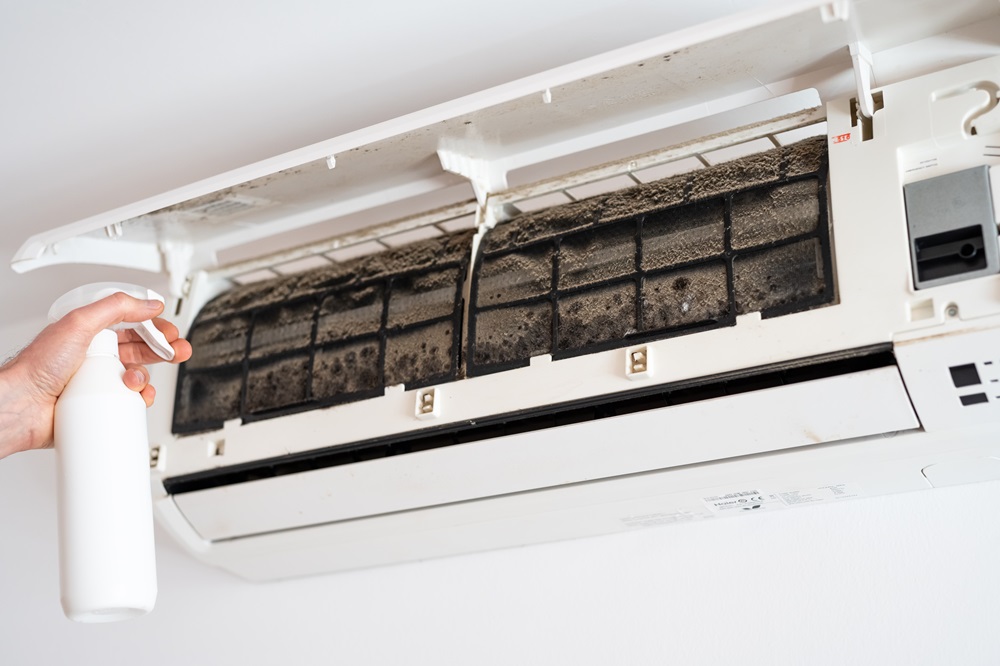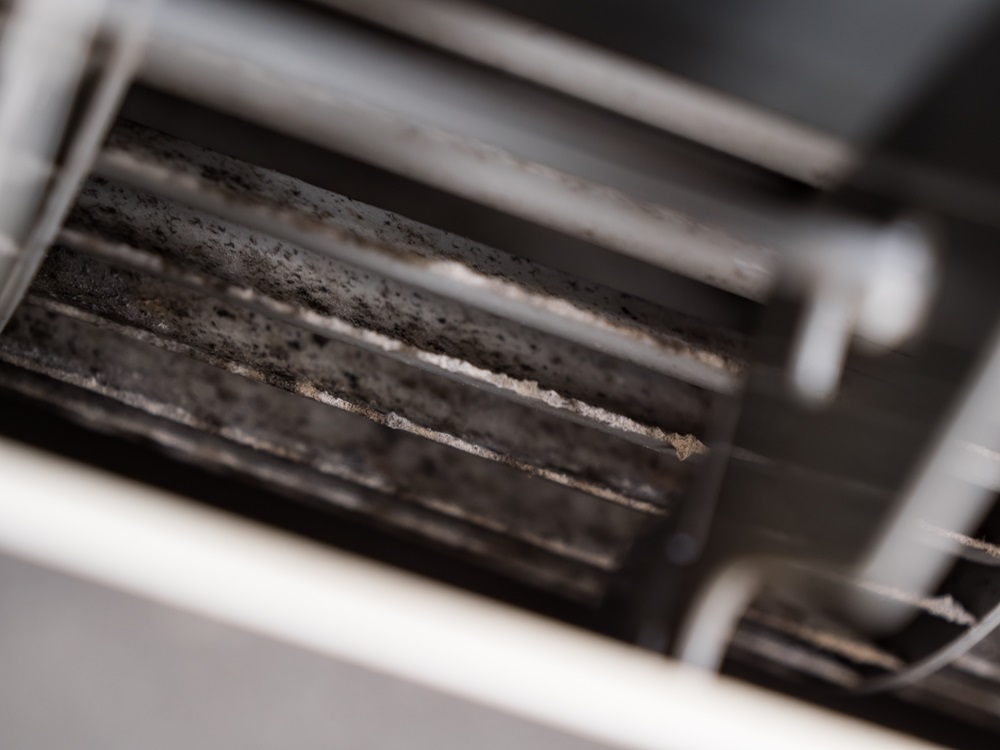How to Clean Mold from Your Air Conditioner Safely

Growing mold in your home is easier than you’d think – simply taking a shower or a bath, or cooking indoors can increase the humidity of your home, effectively making it a better environment for the mold to grow. However, sometimes mold appears in places you’d least expect it to be – such as the inside of your air conditioning unit.
What to do when you realize you’re dealing with a mold-infested AC? How to recognize that that’s what’s happening? And how to get mold out of air conditioner and prevent it from happening again in the future? We talk about this and more below.
Understanding the Dangers of Mold in Air Conditioners
Molds are nothing more than microscopic fungus that can develop on several surfaces and that use spores to reproduce. There are many different types of mold, and while all types should be addressed promptly, black mold in AC unit is especially dangerous for your health, as it can trigger symptoms, such as:
- Trouble breathing
- Irritated nose and sore throat
- Nausea and vomiting
- Rashes or irritated skin
- Attention problems
Additionally, long exposure to it can lead to you developing more serious conditions, such as pneumonia or asthma attacks. Unfortunately, it can be hard to distinguish between mold exposure and common cold or food poisoning, so if your symptoms persist, make sure to visit a medical professional.
How to Detect Mold in Your Air Conditioner
The most obvious sign of mold would be a visual sign – there will be mold not only inside the AC once you open it, but also around it. However, sometimes the mold grows deeper – especially when you have a central AC unit – appearing in the ducts or vents of the system. In those situations it’s not as easy to spot mold, so how can you know if that’s it?
There is another very telling sign – a smelly odor. If your AC has been infested with mold, you will definitely smell it – there will be a sudden moldy or musty smell lingering around your home. It will mostly be noticeable when you turn the air conditioner on.
Tools and Materials You’ll Need for Cleaning Mold Safely
While cleaning your air conditioning unit out of mold is not hard, it requires preparation, especially if you want to get rid of it once and for all – mold is not something to take lightly, so personal safety equipment will be needed.
Here’s what you’ll need to prepare:
- Personal safety equipment (eyewear, gloves, mask, etc.)
- Screwdriver
- Plastic bags
- Vacuum cleaner
- Mold cleaner
- Cloth
Step-by-Step Guide to Cleaning Mold from Your Air Conditioner Safely

Once you have all of your equipment out and your protective gear on, you can move on to the actual cleaning process:
- Turn off the AC unit completely – both for safety, and so that no more mold spreads around your house.
- Use your screwdriver to take out the removable parts – and especially the filter. Inspect it to make sure there are no signs of mold on it. If you notice any, it might be a better solution to replace the filter completely and install a new one. Dispose of it properly by putting it in a plastic bag and tying it.
- Use a vacuum cleaner to take care of the debris and dust – try out different attachments to really get rid of it.
- Prepare the cleaning solution. You have a few options here – you can go for a homemade mold user by using either diluted bleach or white distilled vinegar mixed with water, or you can decide to go with a store-bought cleaner.
- Using a cloth, wipe down the inside of the AC unit – scrub the mold from the inside and around of your air conditioner. Avoid the electrical components!
- Let the cleaning solution sit for about 10 to 20 minutes.
- Rinse the air conditioner by spraying it with clean water and wiping down any remains of the cleaning solution.
- Allow your air conditioner to dry, and reassemble it once everything is dry.
The important thing is that you assess whether you’re able to do it yourself – if you don’t think this is something you’d like to engage in, we would recommend calling a professional. Making a call is also needed when you already cleaned the air conditioner, but the smell still remains or your symptoms persist – the problem might lay somewhere deeper than just in your AC.
How to Prevent Mold from Reappearing
The first step to preventing mold is performing regular maintenance – ideally with the help of professionals. More thorough yearly maintenance checks, ideally done by professionals, should become part of your AC routine, along with regular cleaning, which should be done once a week.
Empty the collection reservoir, if your AC unit has one, regularly. Remember to inspect the filters – if your AC unit uses disposable ones, make sure that you change them whether monthly or as indicated by the manufacturer.
If you need to replace your AC unit completely, either because of mold, age, or other problems, make sure that the one you choose to replace it has humidity control – humidity is one of the main reasons for mold growth, so regulating its levels from the start can be very beneficial in the prevention process.
Another thing is that you should avoid leaving your AC unit turned off completely. Try to leave the unit on the “Auto” setting when being absent for longer periods of time, so that it still turns out from time to time.
| How Often | What Needs to Be Done |
| Monthly (or as needed) |
|
| Yearly |
|
When to Contact a Professional
If, despite you cleaning your AC, the mold is still there, you should call a professional specializing in mold removal. The same goes for when you simply don’t want to deal with the process of mold removal yourself – it’s always better to call someone who has expertise in it, as they can ensure it is done thoroughly.
Another instance where professional help is irreplaceable is when doing more through maintenance checks, especially if you have a central AC unit that can be hard to access without professional knowledge.
FAQs
Should You Run Your AC with Mold in It?
It is definitely not recommended. If you know you have mold growing in your AC and you turn on your AC, you risk spreading its spores to the rest of your house. If someone has respiratory issues or is sensitive to mold, it can end very badly, triggering a reaction. Exposure to mold can result in several symptoms, including coughing, sneezing and sore throat, among others.
It’s important that you address the mold issue as soon as it arises, as staying in a moldy house can have consequences on your health, such as increased risk of developing pneumonia or sinus infections.
Can Black Mold Grow in Air Conditioners?
Even more – black mold can thrive there if the right conditions are met, and especially if there’s moisture.
Is Black Mold in AC Dangerous?
Yes, black mold inside AC unit can be dangerous, especially if you’re exposed to it for a prolonged period of time, as it can trigger health symptoms such as coughing or sore throat, as well as increase your risk of developing conditions such as pneumonia.
The Bottom Line
Mold appearing in your AC unit doesn’t mean that the whole unit needs replacement – there is actually a very simple way to clean it, and bring it back to its former, pre-mold, condition. However, sometimes, even cleaning it does not get rid of the mold – in those cases, you should try professional mold removal help, as your mold might be particularly stubborn, refusing to be cleaned using homemade solutions.
If that doesn’t work, it might unfortunately be time to let it go, and address the deeper issue before installing a completely new AC and risking the same thing happening again. One thing you definitely shouldn’t do is ignore this matter completely – mold can be dangerous to your health, so by leaving it be, you are increasing your risks of developing symptoms such as coughing or sore throat, or worse.
